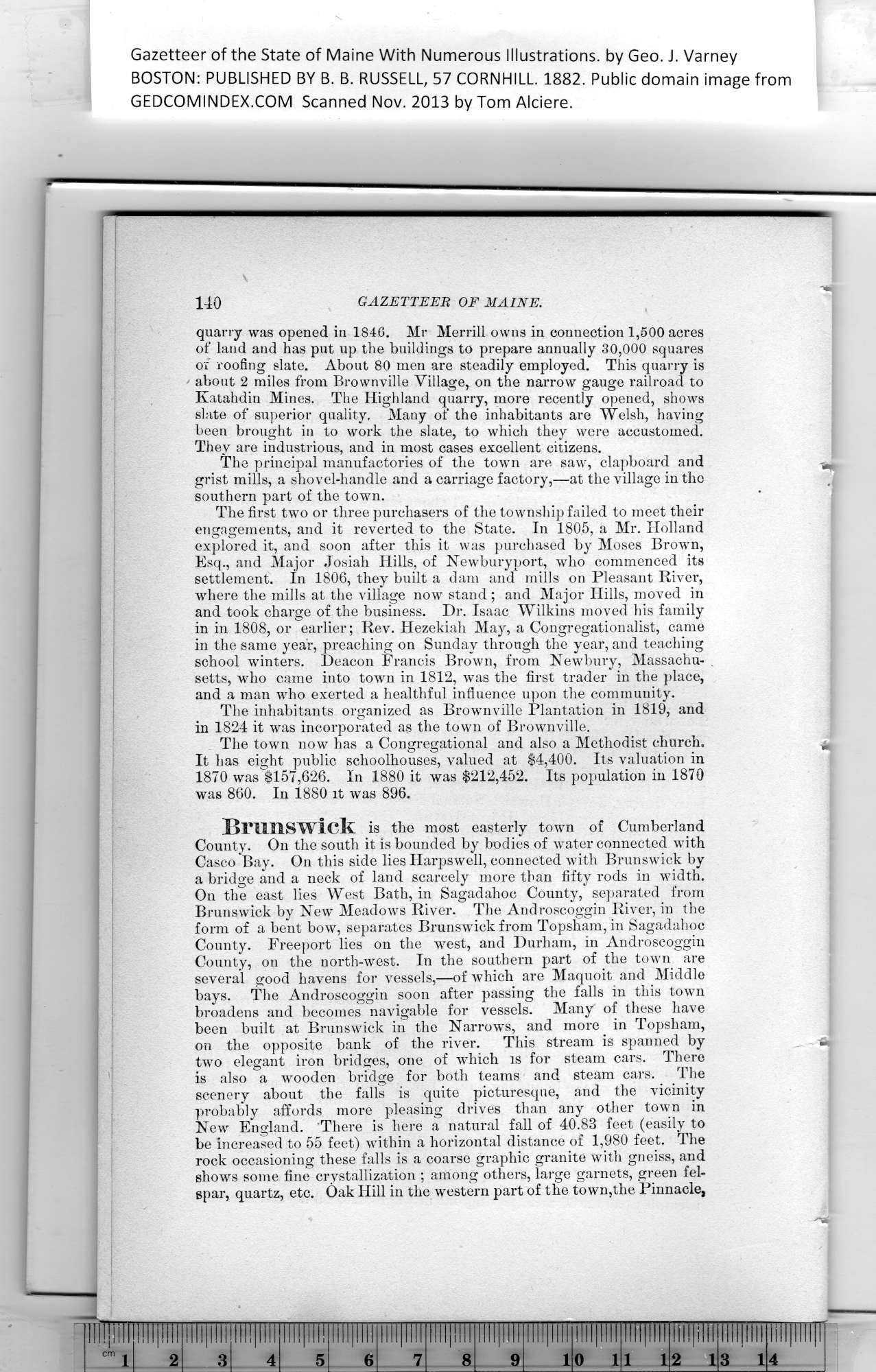|
Gazetteer of the State of Maine With Numerous Illustrations, by Geo. J. Varney
BOSTON: PUBLISHED BY B. B. RUSSELL, 57 CORNHILL. 1882. Public domain image from
140 GAZETTEER OF MAINE.
quarry was opened in 1846. Mr Merrill owns in connection 1,500 acres
of land and has put up the buildings to prepare annually 30,000 squares
of roofing slate. About 80 men are steadily employed. This quarry is
about 2 miles from Brownville Village, on the narrow gauge railroad to
Katahdin Mines. The Highland quarry, more recently opened, shows
slate of superior quality. Many of the inhabitants are Welsh, having
been brought in to work the slate, to which they were accustomed.
They are industrious, and in most cases excellent citizens.
The principal manufactories of the town are saw, clapboard and
grist mills, a shovel-handle and a carriage factory,—at the village in the
southern part of the town.
The first two or three purchasers of the township failed to meet tbeir
engagements, and it reverted to the State. In 1805, a Mr. Holland
explored it, and soon after this it was purchased by Moses Brown,
Esq., and Major Josiah Hills, of Newburyport, who commenced its
settlement. In 1806, they built a dam and mills on Pleasant River,
where the mills at the village now stand; and Major Hills, moved in
and took charge of the business. Dr. Isaac Wilkins moved his family
in in 1808, or earlier; Rev. Hezekiah May, a Congregationalist, came
in the same year, preaching on Sunday through the year, and teaching
school winters. Deacon Francis Brown, from Newbury, Massachu-
setts, wdio came into town in 1812, was the first trader in the place,
and a man who exerted a healthful influence upon the community.
The inhabitants organized as Brownville Plantation in 1819, and
in 1824 it was incorporated as the town of Brownville.
The town now has a Congregational and also a Methodist church.
It lias eight public schoolhouses, valued at $4,400. Its valuation in
1870 was $157,626. In 1880 it was $212,452. Its population in 1870
was 860. In 1880 it was 896.
Brunswick is the most easterly town of Cumberland
County. On the south it is bounded by bodies of water connected with
Casco Bay. On this side lies Harpswell, connected with Brunswick by
a bridge and a neck of land scarcely more tban fifty rods in width.
On the east lies West Batb, in Sagadahoc County, separated from
Brunswick by New Meadows River. The Androscoggin River, in the
form of a bent bow, separates Brunswick from Topsham, in Sagadahoc
County. Freeport lies on the west, and Durham, in Androscoggin
County, on the north-west. In the southern part of the town are
several good havens for vessels,—of which are Maquoit and Middle
bays. The Androscoggin soon after passing the falls in this town
broadens and becomes navigable for vessels. Many of these have
been built at Brunswick in the Narrows, and more^ in Topsham,
on the opposite bank of the river. This stream is spanned by
two elegant iron bridges, one of which is for steam cars. There
is also a wooden bridge for both teams and steam cars. Tbe
scenery about the falls is quite picturesque, and the vicinity
probably affords more pleasing drives than any other town in
New England. There is here a natural fall of 40.83 feet (easily to
be increased to 55 feet) within a horizontal distance of 1,980 feet. The
rock occasioning these falls is a coarse graphic granite with gneiss, and
shows some fine crystallization ; among others, large garnets, green fel-
spar, quartz, etc. Oak Hill in tbe western part of the town,the Pinnacle,
PREVIOUS PAGE ... NEXT PAGE
This page was written in HTML using a program written in Python 3.2
|
